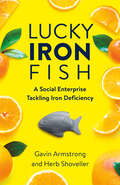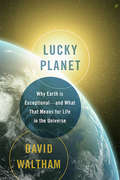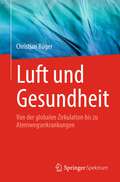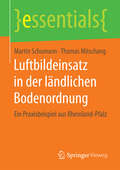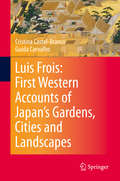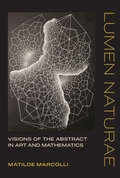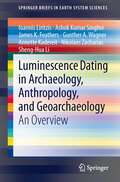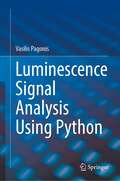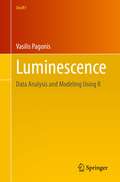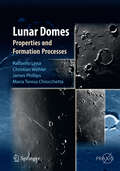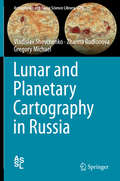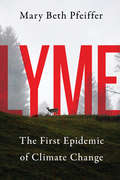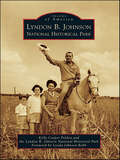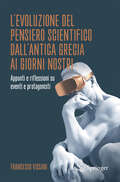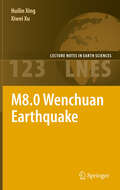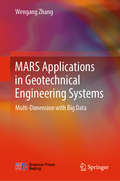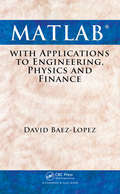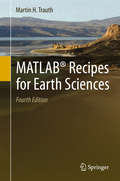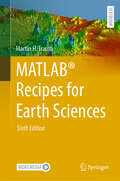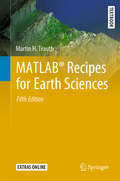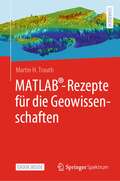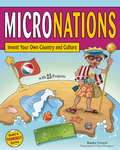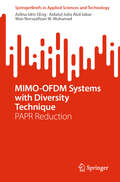- Table View
- List View
Lucky Iron Fish: A Social Enterprise Tackling Iron Deficiency
by Herb Shoveller Gavin Armstrong“The story of the Lucky Iron Fish is a great example of how business can be a force for good.”— MICHELE ROMANOW, Dragons’ Den host and CEO, ClearbancResearch into iron deficiency and entrepreneurial determination brought the Lucky Iron Fish to cooking pots around the world. When Canadian researcher Dr. Christopher Charles was studying the devastation caused by iron deficiency in impoverished populations in Southeast Asia, he discovered an innovative way to help people get iron into their diets: place an iron ingot right into their cooking pots. Dr. Gavin Armstrong, a biomedical scientist and entrepreneur, built upon Charles’s findings to develop, manufacture, and distribute that ingot, which became the Lucky Iron Fish, a cost-effective solution to iron deficiency. The business thrived and the product was recognized around the world by NGOs and organizations such as World Vision, CARE International, Catholic Relief Services, and GlobalMedic. While sustaining growth through the pandemic was a challenge, Lucky Iron Fish met it head-on and now looks ahead to a bright future.
Lucky Planet: Why Earth is Exceptional-and What That Means for Life in the Universe
by David WalthamWhy Earth’s life-friendly climate makes it exceptional--and what that means for the likelihood of finding intelligent extraterrestrial life We have long fantasized about finding life on planets other than our own. Yet even as we become aware of the vast expanses beyond our solar system, it remains clear that Earth is exceptional. The question is: why? In Lucky Planet, astrobiologist David Waltham argues that Earth’s climate stability is what makes it uniquely able to support life, and it is nothing short of luck that made such conditions possible. The four billion year-stretch of good weather that our planet has experienced is statistically so unlikely that chances are slim that we will ever encounter intelligent extraterrestrial others. Citing the factors that typically control a planet’s average temperature--including the size of its moon, as well as the rate of the Universe’s expansion--Waltham challenges the prevailing scientific consensus that Earth-like planets have natural stabilizing mechanisms that allow life to flourish. A lively exploration of the stars above and the ground beneath our feet, Lucky Planet seamlessly weaves the story of Earth and the worlds orbiting other stars to give us a new perspective of the surprising role chance plays in our place in the universe.
Luft und Gesundheit: Von der globalen Zirkulation bis zu Atemwegserkrankungen
by Christian RügerIst frische Luft ein Mythos? In diesem Werk durchstreift der Autor die Lebensräume des Menschen und bietet Einblicke in die jeweils anzutreffenden Luftqualitäten. Aerosole steigen nicht von allein in die Luft auf. Die Partikel lösen sich aus dem festen oder flüssigen Verband. In der Luft kommen alle flugfähigen Masseteilchen miteinander in Kontakt – als ein anschauliches Beispiel dient dem Leser die Entstehung von Wassertropfen. Jede Luftschicht der Atmosphäre wirkt unterschiedlich auf die Atemluft ein und der Wind spielt dabei seine ganz eigene Rolle. Einerseits ist er Verteiler von Schadstoffen, und andererseits Garant frischer Luft am Erdboden. Die Verschmutzung der Luft ruft den Gesetzgeber auf den Plan. Wir erleben derzeit eine rasante Entwicklung von der Aufhebung der Zünfte bis zur Klimadiskussion.Große Relevanz für die Gesundheit besitzt die Schnittstelle zwischen Luft und Mensch: die Atemwege. Deren Schleimhäute stehen im Zentrum unserer Immunabwehr, und müssen einen „Etagenwechsel“ von Infektionen der oberen Atemwege in untere Lungenabschnitte verhindern. Diese und viele weitere spannende Zusammenhänge und Themen im breiten Spektrum zwischen Meteorologie und Atemwegserkrankungen werden anschaulich, gut zugänglich und anhand praktischer Beispiele abgehandelt, um sich eine sichere Plattform zur Beurteilung der Flut von Umweltnachrichten zu schaffen.
Luftbildeinsatz in der ländlichen Bodenordnung: Ein Praxisbeispiel aus Rheinland-Pfalz (essentials)
by Martin Schumann Thomas MitschangIn diesem essential beschreiben Martin Schumann und Thomas Mitschang die Verwendung von Luftbildern in der Flurbereinigungsverwaltung Rheinland-Pfalz. Anhand eines Beispiels stellen die Autoren die Bedeutung der Luftbilder für die Planung von Landentwicklungsmaßnahmen dar. Seit den fünfziger Jahren des letzten Jahrhunderts werden Luftbilder für die unterschiedlichen Zwecke eingesetzt. Dabei haben sich die Qualität der Aufnahmen sowie die Auswertungsmöglichkeiten im Laufe der Jahrzehnte verändert.
Luis Frois: First Western Accounts of Japan's Gardens, Cities and Landscapes
by Cristina Castel-Branco Guida CarvalhoThis book focuses on Luis Frois, a 16th-century Portuguese Jesuit and chronicler, who recorded his impressions of Japanese gardens, cities and building practices, tea-drinking rituals, Japan’s unification efforts, cultural traditions, and the many differences between Europe and Japan in remarkable manuscripts almost lost to time. This research also draws on other Portuguese descriptions from contemporary sources spanning the years 1543 – 1597, later validated by Japanese history and iconography. Importantly, explorer Jorge Alvares recorded his experiences of discovery, prompting St. Francis Xavier to visit Japan in 1549, thus ushering in the “Christian Century” in Japan.During this long period of accord and reciprocal curiosity, the Portuguese wrote in excess of 1500 pages of letters to European Jesuits that detail their impressions of the island nation—not to mention their observations of powerful public figures such as Oda Nobunaga, Toyotomi Hideyoshi, and Sen no Rikyu. In addition to examining these letters, the authors translated and researched early descriptions of 23 gardens in Kyoto and Nara and 9 important cities—later visited by the authors, sketched, photographed and compared with the imagery painted on 16th-century Japanese screens.However, the data gathered for this project was found mainly within five large volumes of Frois’ História do Japão (2500 pages) and his Treaty on Contradictions—two incomparable anthropological works that were unpublished until the mid-20th century for reasons detailed herein. His volumes continue to be explored for their insightful observations of places, cultural practices, and the formidable historical figures with whom he interacted.Thus, this book examines the world’s first globalization efforts that resulted in profitable commerce, the introduction of Portuguese firearms that changed Japan’s history, scientific advances, religious expansion, and many artistic exchanges that have endured the centuries.
Lumen Naturae: Visions of the Abstract in Art and Mathematics
by Matilde MarcolliExploring common themes in modern art, mathematics, and science, including the concept of space, the notion of randomness, and the shape of the cosmos.This is a book about art—and a book about mathematics and physics. In Lumen Naturae (the title refers to a purely immanent, non-supernatural form of enlightenment), mathematical physicist Matilde Marcolli explores common themes in modern art and modern science—the concept of space, the notion of randomness, the shape of the cosmos, and other puzzles of the universe—while mapping convergences with the work of such artists as Paul Cezanne, Mark Rothko, Sol LeWitt, and Lee Krasner. Her account, focusing on questions she has investigated in her own scientific work, is illustrated by more than two hundred color images of artworks by modern and contemporary artists. Thus Marcolli finds in still life paintings broad and deep philosophical reflections on space and time, and connects notions of space in mathematics to works by Paul Klee, Salvador Dalí, and others. She considers the relation of entropy and art and how notions of entropy have been expressed by such artists as Hans Arp and Fernand Léger; and traces the evolution of randomness as a mode of artistic expression. She analyzes the relation between graphical illustration and scientific text, and offers her own watercolor-decorated mathematical notebooks. Throughout, she balances discussions of science with explorations of art, using one to inform the other. (She employs some formal notation, which can easily be skipped by general readers.) Marcolli is not simply explaining art to scientists and science to artists; she charts unexpected interdependencies that illuminate the universe.
Luminescence Dating in Archaeology, Anthropology, and Geoarchaeology: An Overview
by Annette Kadereit Ioannis Liritzis Sheng-Hua Li Rudolf Wagner Jim Feathers Nikolaos Zacharias Ashok SinghviThe field of Luminescence Dating has reached a level of maturity. Both research and applications from all fields of archaeological science, from archaeological materials to anthropology and geoarchaeology, now routinely employ luminescence dating. The advent of optically stimulated luminescence (OSL) techniques and the potential for exploring a spectrum of grain aliquots enhanced the applicability, accuracy and the precision of luminescence dating. The present contribution reviews the physical basis, mechanisms and methodological aspects of luminescence dating; discusses advances in instrumentations and facilities, improvements in analytical procedures, and statistical treatment of data along with some examples of applications across continents, covering all periods (Middle Palaeolithic to Medieval) and both Old and New World archaeology. They also include interdisciplinary applications that contribute to palaeo-landscape reconstruction.
Luminescence Signal Analysis Using Python
by Vasilis PagonisThis book compiles and presents a complete package of open-access Python software code for luminescence signal analysis in the areas of radiation dosimetry, luminescence dosimetry, and luminescence dating. Featuring more than 90 detailed worked examples of Python code, fully integrated into the text, 16 chapters summarize the theory and equations behind the subject matter, while presenting the practical Python codes used to analyze experimental data and extract the various parameters that mathematically describe the luminescence signals. Several examples are provided of how researchers can use and modify the available codes for different practical situations. Types of luminescence signals analyzed in the book are thermoluminescence (TL), isothermal luminescence (ITL), optically stimulated luminescence (OSL), infrared stimulated luminescence (IRSL), timeresolved luminescence (TR) and dose response of dosimetric materials. The open-access Python codes are available at GitHub.The book is well suited to the broader scientific audience using the tools of luminescence dosimetry: physicists, geologists, archaeologists, solid-state physicists, medical physicists, and all scientists using luminescence dosimetry in their research. The detailed code provided allows both students and researchers to be trained quickly and efficiently on the practical aspects of their work, while also providing an overview of the theory behind the analytical equations.
Luminescence: Data Analysis and Modeling Using R (Use R!)
by Vasilis PagonisThis book covers applications of R to the general discipline of radiation dosimetry and to the specific areas of luminescence dosimetry, luminescence dating, and radiation protection dosimetry. It features more than 90 detailed worked examples of R code fully integrated into the text, with extensive annotations. The book shows how researchers can use available R packages to analyze their experimental data, and how to extract the various parameters describing mathematically the luminescence signals. In each chapter, the theory behind the subject is summarized, and references are given from the literature, so that researchers can look up the details of the theory and the relevant experiments. Several chapters are dedicated to Monte Carlo methods, which are used to simulate the luminescence processes during the irradiation, heating, and optical stimulation of solids, for a wide variety of materials. This book will be useful to those who use the tools of luminescence dosimetry, including physicists, geologists, archaeologists, and for all researchers who use radiation in their research.
Lunar Domes: Properties and Formation Processes
by Christian Wöhler Jim Phillips Maria Teresa Chiocchetta Raffaello LenaLunar domes are structures of volcanic origin which are usually difficult to observe due to their low heights. The Lunar Domes Handbook is a reference work on these elusive features. It provides a collection of images for a large number of lunar domes, including telescopic images acquired with advanced but still moderately intricate amateur equipment as well as recent orbital spacecraft images. Different methods for determining the morphometric properties of lunar domes (diameter, height, flank slope, edifice volume) from image data or orbital topographic data are discussed. Additionally, multispectral and hyperspectral image data are examined, providing insights into the composition of the dome material. Several classification schemes for lunar domes are described, including an approach based on the determined morphometric quantities and spectral analyses. Furthermore, the book provides a description of geophysical models of lunar domes, which yield information about the properties of the lava from which they formed and the depth of the magma source regions below the lunar surface.
Lunar and Planetary Cartography in Russia
by Vladislav Shevchenko Zhanna Rodionova Gregory MichaelThis book is the first to document in depth the history of lunar and planetary cartography in Russia. The first map of the far side of the Moon was made with the participation of Lomonosov Moscow University (Sternberg Astronomical Institute, MSU) in 1960. The developed mapping technologies were then used in preparing the "Complete Map of the Moon" in 1967 as well as other maps and globes. Over the years, various maps of Mars have emerged from the special course "Mapping of extraterrestrial objects" in the MSU Geography Department, including the hypsometric map of Mars at a scale of 1:26,000,000, compiled by J. A. Ilyukhina and published in 2004 in an edition of 5,000 copies. A more detailed version of this map has since been produced with a new hypsometric scale. In addition, maps of the northern and southern hemispheres of Mars have been compiled for the hypsometric globe of Mars. Relief maps of Venus were made in 2008, 2010, and 2011, and hypsometric maps of Phobos and Deimos at a scale of 1:60,000 were published in 2011. History of Lunar and Planetary Cartography in Russia provides detailed information on the compilation of this diverse range of maps and will be of interest to all lunar and planetary cartographers.
Luxury Fashion Brand Management: Unifying Fashion with Sustainability (Mastering Fashion Management)
by Olga MitterfellnerThis textbook examines fashion luxury brand management, providing students with a comprehensive understanding of its origins, unique components, current practices, global trade and, most importantly, the application of sustainable models to the industry. It also highlights what makes brands fail and how they can become more resilient. The key content covers the heritage of luxury brands, the importance of craftsmanship and creative direction, the role of luxury conglomerates, cultural awareness and internationalisation, risks of failure and opportunities for revitalisation as well as the application of sustainable measures for a resilient and ethical brand future. Each chapter includes a combination of industry insights, case studies or expert interviews. Coupled with theoretical frameworks and business models, these examples and case studies show how sustainable models can be applied to existing luxury brands and how practices can be embedded into the brand concept. Students are encouraged to think about opportunities and solutions, unique to luxury brand management, and will gain knowledge and skills for a successful future career. A truly global and holistic textbook, Luxury Fashion Brand Management and Sustainability should be core and recommended reading for advanced undergraduate and postgraduate students studying luxury fashion management, luxury brand management, sustainable fashion and responsible business and fashion marketing and communications. Supplementary online resources include chapter-by-chapter PowerPoint slides and a test bank.
Lyme: The First Epidemic of Climate Change
by Mary Beth PfeifferLyme disease is spreading rapidly around the globe as ticks move into places they could not survive before. The first epidemic to emerge in the era of climate change, the disease infects half a million people in the US and Europe each year, and untold multitudes in Canada, China, Russia, and Australia.Mary Beth Pfeiffer shows how we have contributed to this growing menace, and how modern medicine has underestimated its danger. She tells the heart-rending stories of families destroyed by a single tick bite, of children disabled, and of one woman's tragic choice after an exhaustive search for a cure.Pfeiffer also warns of the emergence of other tick-borne illnesses that make Lyme more difficult to treat and pose their own grave risks. Lyme is an impeccably researched account of an enigmatic disease, making a powerful case for action to fight ticks, heal patients, and recognize humanity's role in a modern scourge.
Lyndon B. Johnson National Historical Park
by Kelly Carper Polden Lyndon B. Johnson National Historical Park Lynda Johnson RobbPres. Lyndon B. Johnson took pride in his heritage and in the Texas Hill Country roots of his pioneer ancestors. He delighted in showing guests the ancestral settlement, and his birthplace, boyhood home, and the family treasure: the LBJ Ranch and the home that became known as the Texas White House. LBJ generously gifted these cherished assets to the people of the United States. Lyndon B. Johnson National Historical Park holds more assets significant to an American president than any other U.S. presidential site. Visitors may stroll through the Johnson Settlement, stepping back in time to the 1860s, when President Johnson�s ancestors helped settle Johnson City, which was named after James Polk Johnson, nephew to LBJ�s grandfather. The Boyhood Home and Visitor Center are located close to the Johnson Settlement, and visitors can tour the reconstructed Birthplace and enjoy a scenic drive through the LBJ Ranch before touring the Texas White House. This book illustrates the significance of LBJ�s heritage and the circle of life represented by what is both a birthplace and a final resting place.
Límites Socioculturales de la Educación Ambiental (Acercamiento desde la experiencia cubana)
by Carlos Jesús Delgado DíazEs evidente que el progreso científico-tecnológico, el bienestar de las sociedades industrializadas y el deterioro del medio ambiente se encuentran profundamente relacionadas. Al minarse las bases de los ciudadanos, la preocupación social por lo ambiental se ha manifestado como una institución social de ese vínculo con la naturaleza demandando una nueva educación que incluya la reflexión y modificación de su relación material con el mundo.
L’evoluzione del pensiero scientifico dall’antica Grecia ai giorni nostri: Appunti e riflessioni su eventi e protagonisti
by Francesco VissaniLa scienza, come ogni cosa al mondo, ha avuto un inizio, un'origine. Sebbene non si possa stabilire con precisione il momento esatto degli esordi, il contributo della civiltà greca, come ampiamente attestato dai documenti, è stato cruciale; molti, tra cui l’autore, lo considerano essenziale per la nascita della scienza come la conosciamo. Il libro esplora l'evoluzione del pensiero scientifico con una raccolta di appunti e saggi che, procedendo in ordine cronologico ma senza seguire una struttura rigida, mantiene la lettura istruttiva e interessante. Si esaminano le prime forme assunte dalla scienza, la fioritura dell'ellenismo, la sua crisi e la sua rinascita, con particolare attenzione ai rapporti con la filosofia. Il viaggio inizia con i presocratici e i pitagorici, concentrandosi su Democrito, Platone e Archimede, e continua con un breve passaggio nell'era romana. Continua con il periodo arabo, per passare al Medioevo, con un riferimento a Dante; giunge infine al Rinascimento e ai pensatori moderni tra cui Galilei. Nell'ultima parte viene presentata la storia di alcune delle grandi scoperte della fisica, evidenziandone le relazioni con il pensiero antico; si conclude ragionando di situazioni contemporanee.
M8.0 Wenchuan Earthquake
by Huilin Xing Xiwei XuThe M8.0 Wenchuan Earthquake occurred in China on May 12, 2008, killing over 69,000 people and displacing millions from their homes. This was one of the most catastrophic natural disasters on record. This book includes 5 chapters describing the tectonic setting and historical earthquakes around the Chuan-Dian region, the nucleation of the Wenchuan earthquake, occurrence and aftershocks. The field observations of earthquake induced surface fractures and building damage, form a major and special part of this book and include a large number of digital photos with accompanying explanantions.
MARS Applications in Geotechnical Engineering Systems: Multi-Dimension with Big Data
by Wengang ZhangThis book presents the application of a comparatively simple nonparametric regression algorithm, known as the multivariate adaptive regression splines (MARS) surrogate model, which can be used to approximate the relationship between the inputs and outputs, and express that relationship mathematically. The book first describes the MARS algorithm, then highlights a number of geotechnical applications with multivariate big data sets to explore the approach’s generalization capabilities and accuracy. As such, it offers a valuable resource for all geotechnical researchers, engineers, and general readers interested in big data analysis.
MATLAB with Applications to Engineering, Physics and Finance
by David Baez-LopezMaster the tools of MATLAB through hands-on examplesShows How to Solve Math Problems Using MATLABThe mathematical software MATLAB integrates computation, visualization, and programming to produce a powerful tool for a number of different tasks in mathematics. Focusing on the MATLAB toolboxes especially dedicated to science, finance, and engineering
MATLAB® Recipes for Earth Sciences
by Martin H. TrauthMATLAB® is used for a wide range of applications in geosciences, such as image processing in remote sensing, the generation and processing of digital elevation models and the analysis of time series. This book introduces methods of data analysis in geosciences using MATLAB, such as basic statistics for univariate, bivariate and multivariate datasets, time-series analysis, signal processing, the analysis of spatial and directional data and image analysis. The revised and updated Fourth Edition includes sixteen new sections and most chapters have greatly been expanded so that they now include a step by step discussion of all methods before demonstrating the methods with MATLAB functions. New sections include: Array Manipulation; Control Flow; Creating Graphical User Interfaces; Hypothesis Testing; Kolmogorov-Smirnov Test; Mann-Whitney Test; Ansari-Bradley Test; Detecting Abrupt Transitions in Time Series; Exporting 3D Graphics to Create Interactive Documents; Importing, Processing and Exporting LANDSAT Images; Importing and Georeferencing TERRA ASTER Images; Processing and Exporting EO-1 Hyperion Images; Image Enhancement; Correction and Rectification; Shape-Based Object Detection in Images; Discriminant Analysis; and Multiple Linear Regression. The text includes numerous examples demonstrating how MATLAB can be used on data sets from earth sciences. The book's supplementary electronic material (available online through Springer Link) includes recipes that include all the MATLAB commands featured in the book and the example data.
MATLAB® Recipes for Earth Sciences (Springer Textbooks in Earth Sciences, Geography and Environment)
by Martin H. TrauthMATLAB® is used in a wide range of geoscientific applications, such as for image processing in remote sensing, for generating and processing digital elevation models, and for analyzing time series. This book introduces methods of data analysis in the earth sciences using MATLAB, such as basic statistics for univariate, bivariate, and multivariate data sets, time series analysis, signal processing, spatial and directional data analysis, and image analysis. The text includes numerous examples demonstrating how MATLAB can be used on data sets from the earth sciences. The supplementary electronic material (available online through Springer Link) contains recipes that include all the MATLAB commands featured in the book and example data.
MATLAB® Recipes for Earth Sciences: Matlab® And Design Recipes For Earth Sciences (Springer Textbooks in Earth Sciences, Geography and Environment)
by Martin H. TrauthMATLAB® is used in a wide range of geoscientific applications, e.g. for image processing in remote sensing, for creating and processing digital elevation models, and for analyzing time series. This book introduces readers to MATLAB-based data analysis methods used in the geosciences, including basic statistics for univariate, bivariate and multivariate datasets, time-series analysis, signal processing, the analysis of spatial and directional data, and image analysis. The revised and updated Fifth Edition includes seven new sections, and the majority of the chapters have been rewritten and significantly expanded. New sections include error analysis, the problem of classical linear regression of log-transformed data, aligning stratigraphic sequences, the Normalized Difference Vegetation Index, Aitchison’s log-ratio transformation, graphical representation of spherical data, and statistics of spherical data. The book also includes numerous examples demonstrating how MATLAB can be used on datasets from the earth sciences. The supplementary electronic material (available online through SpringerLink) contains recipes that include all the MATLAB commands featured in the book and the sample data.
MATLAB®-Rezepte für die Geowissenschaften
by Martin H. TrauthTrauth, Martin H.MATLAB® - Rezepte für Geowissenschaften, 1. deutschsprachige Auflage, basierend auf der korrigierten 5. englischsprachigen AuflageMATLAB® wird in einer Vielzahl von geowissenschaftlichen Anwendungen eingesetzt, z.B. zur Bildverarbeitung in der Fernerkundung, zur Erzeugung und Verarbeitung digitaler Höhenmodelle und zur Analyse von Zeitreihen. Dieses Buch führt in Methoden der Datenanalyse in den Geowissenschaften mit MATLAB ein, wie z.B. grundlegende Statistik für univariate, bivariate und multivariate Datensätze, Zeitreihenanalyse, Signalverarbeitung, die Analyse räumlicher und gerichteter Daten und Bildanalyse. Der Text enthält zahlreiche Beispiele, die zeigen, wie MATLAB auf Datensätze aus den Geowissenschaften angewendet werden kann. Das ergänzende elektronische Material des Buches (online verfügbar über Springer Link) enthält Rezepte, die alle im Buch vorgestellten MATLAB-Befehle und die Beispieldaten enthalten. Das Buch soll Student:innen, Doktorand:innen, Postdoktorand:innen und Fachleuten helfen, schnelle Lösungen für gängige Datenanalyseprobleme in den Geowissenschaften zu finden.SystemanforderungenBenutzer:innen dieses Buches benötigen die MATLAB®-Software, die für Windows, macOS und Linux verfügbar ist. Die M-Files und Beispieldaten, die online über Springer Link verfügbar sind, sollten auf allen Plattformen laufen, ohne dass eine Modifikation erforderlich ist. Für diese Ausgabe haben wir MATLAB Version 9.11 (Release 2021b), die Bioinformatics Toolbox Version 4.15.2, die Image Processing Toolbox Version 11.4, die Mapping Toolbox Version 5.2, die Signal Processing Toolbox Version 8.7, Simulink 3D Animation Version 9.3, die Statistics and Machine Learning Toolbox Version 12.2 und die Wavelet Toolbox Version 6.0 verwendet.
MICRONATIONS
by Chad Thompson Kathy CeceriFor anyone who's ever dreamed of ruling over their own empire, here's your chance! Micronations are imaginary countries that have a lot of the same things as real ones: laws, customs, history, and their own flags, coins, and postage stamps. Micronations: Invent Your Own Country and Culture takes readers step-by-step to create their own unique realm, using examples from real nations, micronations, and fictional lands. What makes a country a country? What symbols and systems define a country and help it function? Learn about geography and government, technology and the environment, art and culture, and the literary device of "world-building" used in works like The Hobbit and Harry Potter.Activities show readers how to create authentic-looking artifacts and documents such as maps, currency, passports, a declaration of independence, and a constitution. Kids get to invent their own language, music, games, clothing, food, and holidays to fit their micronation's tradition. Whether they create a land of time travel where every city exists in a different epoch or an underwater monarchy (motto: "Bubbles, bubbles and more bubbles") whose chief export is fish, Micronations: Invent Your Own Country and Culture will engage kids' imagination and teach make-believe rulers how the real world works.
MIMO-OFDM Systems with Diversity Technique: PAPR Reduction (SpringerBriefs in Applied Sciences and Technology)
by Azlina Idris CEng Aidatul Julia Jabar Wan Norsyafizan MuhamadThis book addresses the challenges in wireless communication, particularly focusing on the high Peak-to-Average Power Ratio (PAPR) in MIMO-OFDM systems. As the demand for high-speed, reliable wireless communication continues to evolve, this book provides an in-depth exploration of Orthogonal Frequency Division Multiplexing (OFDM) and Multiple Input Multiple Output (MIMO) technologies, which are essential for modern telecommunications. Readers will find particular interest in the innovative PAPR reduction techniques discussed, which are categorized into signal distortion, coding, and probabilistic methods. These techniques not only aim to mitigate the PAPR issue but also enhance the overall efficiency of wireless systems. The book includes various illustrations, tables, and a structured improving approach, making complex concepts accessible and engaging. The main benefit for readers is the practical application of these techniques, which can lead to improved performance in wireless networks, particularly for telecommunications companies in search of optimizing the systems. This book serves as a valuable resource for researchers and practitioners, providing insights into the latest advancements in PAPR reduction and its implications for future wireless communication technologies.
